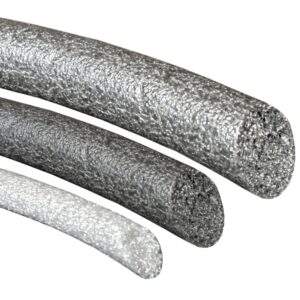If today the term “calfeuting” evokes the action of sealing doors and windows, historically the term has applied first to the manufacture and repair of boats, then in boilermaking… a look back at the history of the term.
Caulking is both the process and the material (also called sealant) used to seal the joints in various structures and certain types of piping. The oldest form of caulking is used to make the seams of wooden boats waterproof and steamproof. Fibrous materials are pushed into the wedge-shaped seams between the boards. A related process was once used to connect parts of cast iron sewer pipes.
The same term also refers to the application of flexible sealing compounds to fill voids in buildings and other structures resistant to water, air, dust and insects, such as doors and windows. Caulking is also useful as a component in firebreaks. In the tunnel digging industry, caulking is based on sealing of joints in prefabricated and segmental concrete tunnels, usually using concrete.

 The rear wand, or joint bottom, is a soft foam product used behind the caulking to ensure the elasticity of the sealant and control the depth of the sealant.
It forces the caulking to be in contact on either side of the aperture to create better adhesion, so it determines the thickness of the caulking and defines the cross section of the caulking.
The rear rod acts as a tiebreaker to prevent caulking from sticking to the bottom of the aperture, which is called a three-sided caulking.
The dorsal stems can be used to reduce caulking consumption by filling part of the joints.
The rear stem is often round in shape, but many specialized formats such as square, rectangular and D-shaped are available on the professional market.
High-temperature support bars are also available. They are available in polyethylene as well as polyurethane and have several widths. The dorsal stem is accessible in open-cell, closed-cell foam.
Open cell foam is porous and allows gases to pass through that could cause blisters.
In addition, the open cell rod allows air to reach the back of the sealant, which accelerates hardening when used with hardened sealants such as silicone. The open alveoli stem is more compressible than the closed alveoli foam and should have a diameter 0.25 larger than the joint.
Closed cell foam does not absorb water. Closed cell rods should avoid compression.
The rear wand, or joint bottom, is a soft foam product used behind the caulking to ensure the elasticity of the sealant and control the depth of the sealant.
It forces the caulking to be in contact on either side of the aperture to create better adhesion, so it determines the thickness of the caulking and defines the cross section of the caulking.
The rear rod acts as a tiebreaker to prevent caulking from sticking to the bottom of the aperture, which is called a three-sided caulking.
The dorsal stems can be used to reduce caulking consumption by filling part of the joints.
The rear stem is often round in shape, but many specialized formats such as square, rectangular and D-shaped are available on the professional market.
High-temperature support bars are also available. They are available in polyethylene as well as polyurethane and have several widths. The dorsal stem is accessible in open-cell, closed-cell foam.
Open cell foam is porous and allows gases to pass through that could cause blisters.
In addition, the open cell rod allows air to reach the back of the sealant, which accelerates hardening when used with hardened sealants such as silicone. The open alveoli stem is more compressible than the closed alveoli foam and should have a diameter 0.25 larger than the joint.
Closed cell foam does not absorb water. Closed cell rods should avoid compression.
Historical uses of the word caulking

Old-town boat caulking in Zanzibar(image source Will to go)
Wooden shipbuilding
The dried caulking on the Severn Spry trowel is now on display on the ground. The traditional caulking tools of wooden ships are mallet, caulking seat, caulking irons, cotton and oak. A caulking mallet, a tar pot and a piece of petrified tar were found in Mary Rose’s 16th century car. Traditional caulking applied to wooden containers requires cotton and oak fibres (hemp fiber dipped in pine tar). These fibres are pressed into the wedge-shaped joint between the planks, using a caulking mallet and a large scissor-shaped tool called caulking iron. The caulking is then covered with putty in the case of hull or deck joints with molten pine pitches, during a calibration process. The modern marine sealant is frequently used in place of the field, or even to replace the oak and cotton itself.Iron or steel shipbuilding
In the construction of steel or iron riveted vessels, caulking consisted of making the seals watertight by inserting a thick, blunt scissor-shaped tool into the veneer adjacent to the joint. This had the effect of moving the metal in a tight fit with the adjacent piece. Originally, pneumatic tools were used. With the advent of arc welding for shipbuilding, the caulking of steel ships has become obsolete.Boiler
Iron and steel caulking, of the type described above for ship hulls, was also used by boilermakers during the riveted boilers to make the seals water and steamproof.Modern use in construction
The verb caulking may refer to the caulking substance or the application process. The term caulking has spread to the construction sector, i.e. the activity of filling joints and voids in buildings. The function of caulking is to providethermal insulation of doors and windows,to control water penetration and to reduce noise.Extruded silicone caulking from a caulking gun.
Silicone-based caulking is also used for bathroom seals. The plumber gently spreads it around the edge when the sink is turned over, providing perfect sealing when installed in its final position. This is mainly done with ready-to-use construction chemicals sold such as caulking, silicone, polyurethane, polysulfide, polyurethane and acrylic sealant.Backer rod / rear rod
 The rear wand, or joint bottom, is a soft foam product used behind the caulking to ensure the elasticity of the sealant and control the depth of the sealant.
It forces the caulking to be in contact on either side of the aperture to create better adhesion, so it determines the thickness of the caulking and defines the cross section of the caulking.
The rear rod acts as a tiebreaker to prevent caulking from sticking to the bottom of the aperture, which is called a three-sided caulking.
The dorsal stems can be used to reduce caulking consumption by filling part of the joints.
The rear stem is often round in shape, but many specialized formats such as square, rectangular and D-shaped are available on the professional market.
High-temperature support bars are also available. They are available in polyethylene as well as polyurethane and have several widths. The dorsal stem is accessible in open-cell, closed-cell foam.
Open cell foam is porous and allows gases to pass through that could cause blisters.
In addition, the open cell rod allows air to reach the back of the sealant, which accelerates hardening when used with hardened sealants such as silicone. The open alveoli stem is more compressible than the closed alveoli foam and should have a diameter 0.25 larger than the joint.
Closed cell foam does not absorb water. Closed cell rods should avoid compression.
The rear wand, or joint bottom, is a soft foam product used behind the caulking to ensure the elasticity of the sealant and control the depth of the sealant.
It forces the caulking to be in contact on either side of the aperture to create better adhesion, so it determines the thickness of the caulking and defines the cross section of the caulking.
The rear rod acts as a tiebreaker to prevent caulking from sticking to the bottom of the aperture, which is called a three-sided caulking.
The dorsal stems can be used to reduce caulking consumption by filling part of the joints.
The rear stem is often round in shape, but many specialized formats such as square, rectangular and D-shaped are available on the professional market.
High-temperature support bars are also available. They are available in polyethylene as well as polyurethane and have several widths. The dorsal stem is accessible in open-cell, closed-cell foam.
Open cell foam is porous and allows gases to pass through that could cause blisters.
In addition, the open cell rod allows air to reach the back of the sealant, which accelerates hardening when used with hardened sealants such as silicone. The open alveoli stem is more compressible than the closed alveoli foam and should have a diameter 0.25 larger than the joint.
Closed cell foam does not absorb water. Closed cell rods should avoid compression.



